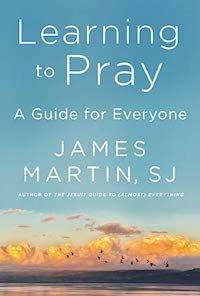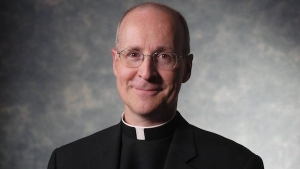On Learning to Pray, and Reflecting on Prayer, with Father James Martin by Joe Pagetta
My first experience with the power of prayer is also one of my earliest memories—and a little bit of family lore. My mother had a difficult pregnancy with me, her third child, and the story is that she prayed to Saint Joseph every day to ask that I be born healthy. In exchange for that intervention, she would name me after him. I was born healthy and was named Joseph. My mother didn’t even bother to give me a middle name. It’s a story she told me from the moment I could comprehend it, and she never stopped. In a house with a picture of the Sacred Heart whose eyes followed me everywhere, with a mother and a grandmother who both prayed Novenas and the Rosary often, I also believed it. Forget for a moment the pressure that puts on someone to live a life worthy of such an auspicious beginning.
My second experience occurred not long after my grandfather died, when I was eight years old, at Saint Patrick’s Cathedral in New York City. I grew up in Jersey City, New Jersey, across the river from Manhattan, and trips to the city, while not a regular occurrence, were not uncommon. It was Christmas time, and we had likely come to see the Rockefeller Center Christmas tree. I kneeled in a pew on the left side of the sanctuary, close to the Altar of the Holy Face (also known as the replica of Veronica’s Veil) and prayed to God that my grandfather was okay, that he had made it to heaven. In the Holy Face, Jesus’s eyes are closed. But during my prayer, I raised my head to look up at the Holy Face, and Jesus’s eyes were open, looking directly at me. I was stunned but not frightened. We exchanged glances in a moment of understanding before I lowered my head in prayer again. To this day, I remember that moment vividly.
 What my mother was doing when she was pregnant with me, and what I was doing at Saint Patrick’s, were forms of petitionary prayer—the most common form of prayer, as Rev. James Martin, S.J., tells us in his new book, Learning to Pray. It “enjoys ancient Hebrew roots, is promoted by Jesus, and is enacted by the early church,” Father Martin reminds us. In fact, throughout the Old Testament, “men and women regularly request God’s help, calling on God for the birth of a child, for deliverance from enemies, for relief from suffering, for rain, simply for God’s presence.” My mother’s prayer has precedent in the First Book of Samuel, when Hannah, who is childless, petitions God: “O Lord of hosts, if only you will look on the misery of your servant, and remember me and not forget your servant, but will give to your servant a male child, then I will set him before you as a nazirite until the day of his death.” She has a son and names him Samuel. She also promises God that her son will not drink alcohol or cut his hair. (That’s where the comparisons with my mother’s prayer ends. Sips of Gallo wine mixed with 7 Up at Sunday dinners as a child, and nips of Amaro when I was teething or had a stomachache, would have made the alcohol part impossible. I also inherited my grandfather’s high forehead and receding hairline, which took care of the other thing.)
What my mother was doing when she was pregnant with me, and what I was doing at Saint Patrick’s, were forms of petitionary prayer—the most common form of prayer, as Rev. James Martin, S.J., tells us in his new book, Learning to Pray. It “enjoys ancient Hebrew roots, is promoted by Jesus, and is enacted by the early church,” Father Martin reminds us. In fact, throughout the Old Testament, “men and women regularly request God’s help, calling on God for the birth of a child, for deliverance from enemies, for relief from suffering, for rain, simply for God’s presence.” My mother’s prayer has precedent in the First Book of Samuel, when Hannah, who is childless, petitions God: “O Lord of hosts, if only you will look on the misery of your servant, and remember me and not forget your servant, but will give to your servant a male child, then I will set him before you as a nazirite until the day of his death.” She has a son and names him Samuel. She also promises God that her son will not drink alcohol or cut his hair. (That’s where the comparisons with my mother’s prayer ends. Sips of Gallo wine mixed with 7 Up at Sunday dinners as a child, and nips of Amaro when I was teething or had a stomachache, would have made the alcohol part impossible. I also inherited my grandfather’s high forehead and receding hairline, which took care of the other thing.)
While my prayer at Saint Patrick’s was petitionary, what happened during it can only be described as mystical, something Father Martin explores in chapters on childhood prayer and “What Happens When We Pray.” Fittingly, his introduction to mystical prayer begins when he was about the same age as I was during that moment at Saint Patrick’s. He recalls a time bicycling along a bumpy, dirty path through a meadow he knew well on his way to elementary school. He begins to lose his balance and sets his feet down to right himself. As he recalls:
All around me was so much life—the sights, the sounds, the smells—and suddenly I had a visceral urge not only to be a part of it, but also to know it and possess it. I felt loved, held, understood. The desire for everything, somehow for a full incorporation into the universe, and a desire to understand what I was doing here on this earth filled me.
“It wasn’t a vision,” he goes on. “But I knew something had happened.” While our mystical prayer experiences may have been different, that they happened to us as children may not be uncommon. Children seem to be more open to these kinds of connections. It was to children, after all, that both Our Lady of Lourdes and Our Lady of Fatima appeared, and Jesus himself says in Matthew 18:3, “Unless you change and become like children, you will never enter the kingdom of heaven.”
But what now for us adults? Do we need a mystical experience to know God is with us, to complete the connection we seek in our prayer? Is my invocation of the name of Saint Gerard, when I pray with my daughters at night, gratitude enough for the gift of safe delivery I petitioned for, with his prayer card tucked in my pocket, in the delivery room? Is my daily Rosary practice, and all these Hail Marys and Our Fathers, delivering me or merely distracting me from the inevitable start of the day? And while I’ve read Thomas Merton’s New Seeds of Contemplation and Contemplative Prayer, am I truly achieving a contemplative state in my prayer, or am I just kidding myself?
It was these questions that led me to Father Martin’s new book while on retreat at Ignatius House in Atlanta. I was already familiar with him from following his social media channels and reading his work in America. I was also inspired by his book Building a Bridge. Picking up Learning to Pray felt like catching up with an old friend. I had come to the retreat for the silence and the reflection, but my true desire was an introduction to Ignatian spirituality and a deepening of my prayer life. To that end, Father Martin, as a Jesuit, expands in his book on some of the prayer techniques I was introduced to on retreat. He dedicates an entire chapter to the Jesuit practice of the Examen, the more common name for Saint Ignatius’s “examination of conscience.” Quoting Father George Aschenbrenner’s book Consciousness Examen, he states that the role of the Examen is to see where God is “affecting and moving us.” It was from Father Martin’s Daily Examen podcast that I first learned of the Examen, so I welcomed his lengthier step-by-step exploration of the practice, taking us from Presence to Gratitude to Review to Sorrow to Grace. Of step 2, he writes that “when taken to the extreme, our day becomes nothing more than a series of problems. As a result, our minds are drawn more to challenges than blessing.”
He continues, “Beginning the Examen with gratitude forces us to move away from problem-solving and recognize the blessings as well as the challenges.” The insight resonated almost immediately. I read the chapter in the evening after a challenging day at work. I was exhausted by the time my wife came home, and rather uncharacteristically negative. All I could talk about were the things that went wrong during the day, the things that could have potentially been disasters. But thanks to Father Martin’s suggestion, I recalled that my day had actually started with an email from an acquaintance I hadn’t seen or heard from since at least pre-pandemic, perhaps longer. It was a simple message of hello that ended with, “Please stay in touch. I count you as a bright spot in my world.” It was a lovely email to receive, and yet somehow I had let the challenges of the day overshadow it. Learning to Pray reminded me that the Examen is a call to notice everything in the day, but especially the blessings, for we’re wired to focus on the negative.

Father James Martin, S.J.
The most fulfilling part of my retreat at Ignatius House, at least in terms of expanding my prayer practice, was receiving spiritual direction on the Jesuit tradition of imaginative prayer. I had heard about it, but was under the impression that you needed direction to truly employ it. I believe that’s true, and for those not on retreat with spiritual direction, Father Martin does an outstanding job walking us through the practice. He quotes his assistant novice director David Donovan, who once called it “composition of place”: “David described using your imagination to ‘place yourself’ in a scene from the Bible and then paying attention to what came up in prayer.”
On retreat, as we were focusing on the Paschal Mystery, spiritual director Father Joe Lingan invited us, through chosen artwork, to imagine ourselves at the Last Supper and Final Discourse, as told in John 13:31–17:26, and at the Crucifixion. In both instances, something remarkable happened that both comforted me and brought me closer to Jesus. As I imagined myself in the Upper Room as Jesus gathered with his disciples for the final meal, I began first with the smell and taste of the food. I placed some of my favorite Middle Eastern dishes on the table to help with my visualization. I heard the sounds of everyone talking over one another in splintered but joyous conversation. But then it got quiet and Jesus began to speak. Here, in place of Jesus, I heard my own father’s voice as he was dying. The last words he said to me were, “take care of your sister.” And then I heard the voice of my dear friend, Tom, who had also acted as father figure and mentor to me. Tom died of a massive heart attack, alone in his house, this past August. I wondered, if he knew he was dying, what he might have imparted to me and his sons and daughters-in-law and grandchildren and all the people he loved and who loved him. He was the most beautiful person I know, and I can imagine his call for us all to love and care for one another as he loved us. He would have also reminded us to have fun and enjoy our lives together. It was moving to be that close to Tom again, as I felt I never had the opportunity, in times of Covid, to fully grieve his death. I missed him terribly. But the arrival of both my father and Tom’s voices in that moment served a much deeper purpose; it made Jesus more fully human to me. It made him a man, with his loved ones, like us.
At the Crucifixion, I heard a mix of more splintered conversations, this time punctuated by shouts and moans and cries and wailing. I crouched down to speak to a soldier sitting forlorn and holding a piece of Jesus’s clothing. The soldier believed Jesus was the Son of Man and could not reconcile what he had done. I tried to comfort him. And then I made my way over to Jesus on the Cross where his Mother Mary was kneeling, nearly crumbled and sobbing. I knelt beside her and put my arms around her, gently pulling her close to steady her shaking. And something remarkable: a hand on my back. It was Mary Magdalene, comforting me. I broke down in my own tears at the beauty and mystery of it. I thought again of Tom, this time at the small viewing we had for close friends and family, and how his sons and daughters-in-law comforted me in my trembling and heaving. They had always treated me as family, but in the moment, as I tried to comfort them, they were caring for me. Again, Jesus, along with Mary and Mary Magdalene, became more fully human.
It would not be a book on prayer if Father Martin did not cover the means by which most of us were introduced to prayer, and how many of us still speak to God. In a chapter titled “Now I Lay Me Down to Sleep,” he explores what he calls rote prayers—the “Hail Mary” and the “Our Father” among the most popular, and other less popular but equally as powerful ones you may want to add to your arsenal, like the Memorare and Thomas Merton’s “My Lord God.” I have been saying rote prayers my whole life, and still use them every day, either in calling myself to prayer in the morning or putting my girls to bed at night. The “Hail Mary” also comes in handy to calm me during moments of anxiety (like the takeoff and landings of planes). Rote prayers have their purpose, as Father Martin tells us, but they can also hinder us:
Rote prayer can sometimes be a barrier to greater intimacy with God, especially for those who may be reluctant to open themselves up to God fully. Because of their formality, rote prayers may keep God at arm’s length and prevent people from expressing themselves in more personal ways. This can preclude deeper intimacy.
“But it doesn’t have to,” Father Martin adds hopefully. I pray the Rosary most mornings. My spiritual director in Nashville recently asked me what I got out of it. He asks most people who pray the Rosary the same question, because he’s genuinely curious. Outside of its meditative properties, and the lift I feel in praying the “Hail, Holy Queen” at the end, what I find most helpful is contemplating the mysteries before each decade. I find I continually discover insights to consider. I’m always moved by the second Joyful Mystery, the Visitation. The booklet I use quotes Luke 1:41–42, when Elizabeth hears the greeting of Mary, “and the child leapt in her womb,” and Elizabeth “was filled with the Holy Spirit and she exclaimed with a loud cry, ‘Blessed are you among women, and blessed is the fruit of your womb.’” Elizabeth’s genuine joy and excitement always strikes me. Setting aside the sacredness of these individuals for a moment, here are two women, one who has had trouble conceiving and is now into her older years, and one who is but a teenager, whose pregnancy is miraculously conceived. It’s tempting to consider that Elizabeth might be a little jealous or even envious of her cousin, Mary, for things being a little easier for her. Perhaps even Mary’s pregnancy steals a bit of her thunder. They are human, after all. But no, she is filled with complete and utter joy. I wonder if I’m happy for the success of my friends and family. Do I celebrate their joys with them? Or am I envious of what I do not have, or have achieved with more struggle? It’s a great thing to contemplate as I begin my day.

Ludovico Mazzolino, “The Twelve-Year-Old Jesus Teaching in the Temple,” oil on wood, 1524
I also find myself contemplating the fifth Joyful Mystery, “The Finding in the Temple.” For most of my life, the way I have understood this story is that Jesus, as the age of 12, was some kind of theological whiz kid, holding court among the elders at the Temple. But as Luke 2:46–47 tells us, he was “sitting among the teachers, listening to them and asking them questions.” It’s another great insight as I begin my day: Am I listening?
Beyond my contemplation of the Mysteries, there is another reason I pray the Rosary. My mother has always prayed the Rosary. She has dementia now and resides in a nursing facility, and when I see her, or Facetime together as we’ve done during the pandemic, she tells me she still prays the Rosary every morning. I’m not sure if she really does anymore, but I always tell her that I’m praying it, too, and perhaps, on some mornings, we are praying it together. Which connects me back to my mother, the person who introduced me to prayer and taught me about its power, in a way her disease and distance no longer make possible.
It was Learning to Pray that reminded me of all these connections, and that created an opportunity for me to reflect on my prayer life. In a chapter entitled “Praying with Sacred Texts,” Father Martin explores lectio divina, the practice of praying by reading and contemplating sacred texts. My lectio divina practice has usually involved the aforementioned works by Thomas Merton, the letters of Saint Pio of Pietrelcina (aka Padre Pio) or Thomas à Kempis’s devotional classic, Imitation of Christ, among the many other spiritual books scattered among my shelves. Whether or not Learning to Pray qualifies as lectio divina—Father Martin himself might dismiss the suggestion—it’s a welcome addition to my library, and offers plenty of advice on ways to stop and notice God’s presence, through prayer, in our life. And that, to me, is sacred.
Joe Pagetta is a museum professional, arts writer and personal essayist whose work has appeared in America, Ambassador Magazine (the National Italian American Foundation), Chapter 16, Wordpeace, Ovunque Siamo, and more. He has a B.A. from Saint Peter’s University and currently serves as the director of communications for the Tennessee State Museum in Nashville, Tennessee. More at JoePagetta.com.





Leave a Reply
Want to join the discussion?Feel free to contribute!